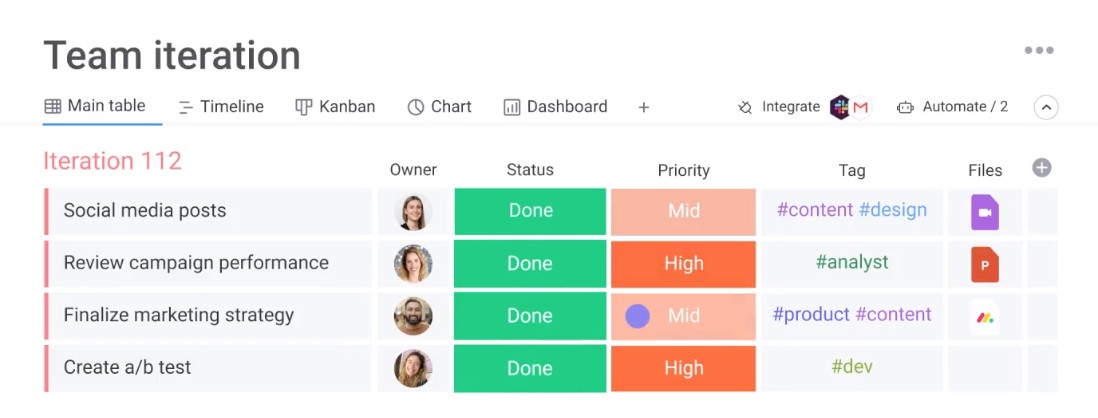5 Tips to Manage Remote Teams Like a Pro
Blog Categories:
Published:
February 18, 2023
Reading Time:
6 minutes

Let’s start this article with some jaw-dropping stats. A few months ago, McKinsey published the results of its recent survey that was related to remote working. Needless to say, the results were astonishing.
58% of the 25,000 respondents said that they work from home at least one day a week. 35% of them said that they have the choice to be able to work from home five days a week. And a whopping 87% said that they will take a job that allows them to work flexibly.
Do you see where this is going? People want remote working! They want flexibility. They want to spend time with their loved ones and still have a career. They want to be able to go buy groceries at 2:00 PM without seeking written permission from their manager.
The whole concept of making adults sit in a room like school kids is starting to fade away, and rightfully so. Most workers are responsible adults, and they can work with responsibility whether someone is looking over their shoulder or not.
But is it really possible to manage staff if they are not in the office? What if they are not really ‘working’? And wouldn’t there be a lack of coordination if everyone is not in the same building?
Well, in this article, we will try to answer all these questions through the 5 tips to manage remote teams. So, let’s dive into it.
58% of the 25,000 respondents said that they work from home at least one day a week. 35% of them said that they have the choice to be able to work from home five days a week. And a whopping 87% said that they will take a job that allows them to work flexibly.
Do you see where this is going? People want remote working! They want flexibility. They want to spend time with their loved ones and still have a career. They want to be able to go buy groceries at 2:00 PM without seeking written permission from their manager.
The whole concept of making adults sit in a room like school kids is starting to fade away, and rightfully so. Most workers are responsible adults, and they can work with responsibility whether someone is looking over their shoulder or not.
But is it really possible to manage staff if they are not in the office? What if they are not really ‘working’? And wouldn’t there be a lack of coordination if everyone is not in the same building?
Well, in this article, we will try to answer all these questions through the 5 tips to manage remote teams. So, let’s dive into it.
1. Trust Them to Get the Job Done
According to a UK survey, two-thirds of business owners don’t trust their team to work remotely. Well, you can only imagine why. It’s likely that these employers think that their employees will just slack off and not finish their tasks. Maybe that’s why they feel the need to have all employees inside the office and monitor their activity.
If you watch movies from the 80s or 90s, you’ll notice something very peculiar about workplaces. Generally, there’s a mean boss standing behind an employee and managing every single aspect of their job. But such behavior should not be encouraged in modern times. We can do way better than that.
You see, trust is a very important aspect of remote work. You have to believe that your remote team will do the right thing sincerely even when no one is watching. As a manager of a remote team, once you establish trust, working with your staff becomes a heck of a lot easier. On the other hand, if you don’t even trust remote employees, that may put a lot of stress on them, too. As a result, they may start looking for a company that trusts them.
If you watch movies from the 80s or 90s, you’ll notice something very peculiar about workplaces. Generally, there’s a mean boss standing behind an employee and managing every single aspect of their job. But such behavior should not be encouraged in modern times. We can do way better than that.
You see, trust is a very important aspect of remote work. You have to believe that your remote team will do the right thing sincerely even when no one is watching. As a manager of a remote team, once you establish trust, working with your staff becomes a heck of a lot easier. On the other hand, if you don’t even trust remote employees, that may put a lot of stress on them, too. As a result, they may start looking for a company that trusts them.
KEY TAKEAWAYS
- Research suggests that many employers are still not willing to let staff work remotely. The main reason behind this is a lack of trust. However, not trusting employees may result in stress and job dissatisfaction.
- If you manage remote teams, you should judge them by the outcomes they produce instead of counting the hours they work.
- Many articles on the internet suggest over-communication and daily checking-in sessions. However, this may not always be the best idea. You should try to only communicate when necessary. This will save your time, and theirs, too.
- Human connections are important when you manage remote teams. Try to make remote team members feel like a part of an organization. Encourage them to interact with each other and wish them well on special occasions.
- Use more technology than just email and Slack. Choose the right software and online platforms as per your needs.
2. Measure the Results, Not the Hours Worked
Frankly, the number of hours worked matters only in certain professions. For instance, a nurse has to work for a specific number of hours to ensure that patients stay safe. A construction manager may need to be on-site for 8 hours a day to give directions to subordinates. However, when you hire knowledge workers, like freelance consultants, copywriters, graphic designers, etc., the number of hours becomes irrelevant.
When it comes to knowledge work, it's the outcome that you should focus on. This doesn’t necessarily mean that the remote team will get away with working merely 2 hours a day. It may take them 2 hours or 10 hours to complete a task—but if they’re diligent and talented, they will give their best on every task. And that’s the only thing that should matter.
When it comes to knowledge work, it's the outcome that you should focus on. This doesn’t necessarily mean that the remote team will get away with working merely 2 hours a day. It may take them 2 hours or 10 hours to complete a task—but if they’re diligent and talented, they will give their best on every task. And that’s the only thing that should matter.
3. Check-In on Them Only When Necessary
One of the main benefits of remote work is that workers who don’t want to be micromanaged can work in peace. But many managers unknowingly use technology to micromanage remote workers—which can be frustrating. You may have read many articles online about managing remote workers that say, “check in on them daily.” Really? Do you really need to ask remote workers what they’re doing every day? Well, not quite. Although it may be necessary in some cases, you don’t need to send a message or email to remote employees every day.
A rather favorable alternative to this may be daily stand-ups. Through this, remote workers can voluntarily mention the tasks they’re working on a daily basis. They can also add if there are any blockers. As a manager, this will make things way simpler for you because you won’t have to talk to every remote staff member every day.
4. Don’t Let the Distance Make Them Feel Distant
Since the beginning of time, humans have generally lived in tribes. Meaning that we are used to living and working in close proximity to each other. So, working remotely is not necessarily what humans are used to naturally. And this could lead to certain issues like loneliness, a lack of connection with coworkers, job insecurity, and feeling disconnected.
If you want to manage remote teams efficiently, you must have a high emotional quotient (EQ). After all, you’re dealing with humans, not robots. So, a personal connection is key here. This can be done in several ways. First, you could organize monthly video conferences and ensure that every team member knows others on the team. Then, you could also encourage team members to add each other on social networking platforms like LinkedIn.
Finally, to add more personal touch, make sure you wish them on their birthdays and anniversaries, give them encouragement when they achieve a goal, and be available for them if they need help.


Apart from the aforementioned platforms, you could also try Trello, Microsoft Projects, Wrike, and Asana, to name a few. Remember, emails and messages are obvious parts of remote work. However, you could make things far more efficient by using additional software.
On a positive note, businesses no longer need to rent huge offices and pay enormous running costs like electricity, water, and other utilities. If you’re open-minded to remote work as a business owner, it may be the best blessing you’ve received in business. Furthermore, employees find happiness in flexibility. And happy employees are productive employees. And productive employees bring big profits to the company. So, give them what they want, and you’ll get what you want in return as well.
Now, once you’ve hired top talent, you may also want to know the tactics to retain them. A few months ago, the Great Resignation was on the rise. Many talented workers left their jobs and went on their own paths. So, if you want some tips on how to retain your best team members, check this out: 3 Antidotes to the Great Resignation
If you want to manage remote teams efficiently, you must have a high emotional quotient (EQ). After all, you’re dealing with humans, not robots. So, a personal connection is key here. This can be done in several ways. First, you could organize monthly video conferences and ensure that every team member knows others on the team. Then, you could also encourage team members to add each other on social networking platforms like LinkedIn.
Finally, to add more personal touch, make sure you wish them on their birthdays and anniversaries, give them encouragement when they achieve a goal, and be available for them if they need help.
5. Use Software and Online Platforms
When you manage remote teams, it’s likely that you’ll use emails, Slack, and Zoom. But you could consider more software services depending on your needs. Let’s dig deeper.
(A sneak peek of Monday.com project management platform)
Monday.com, for instance, is a platform that is widely popular among managers who manage remote teams. As you can see in the image, this platform allows you to give ownership of tasks to different team members, set priorities, add tags, and even upload files once the task is completed. The interface is well-designed and doesn’t have much clutter. The best part is, you could also integrate it with Gmail and Slack. How convenient!
(A sneak peek of Notion in action)
Another platform that can come in handy is Notion. Notion is another very renowned platform used by remote workers. Notion is like Google Docs on steroids! Along with the usual features of Docs, Notion also has project management capabilities. This platform can also cut the need for those time-consuming meetings as it enables one to view the progress of every task with a few clicks.Apart from the aforementioned platforms, you could also try Trello, Microsoft Projects, Wrike, and Asana, to name a few. Remember, emails and messages are obvious parts of remote work. However, you could make things far more efficient by using additional software.
Final Thoughts
Remote work is here to stay. However, it could either be completely remote or a hybrid of remote and office work. So, no matter how much companies disagree with it, the market has made its decision.On a positive note, businesses no longer need to rent huge offices and pay enormous running costs like electricity, water, and other utilities. If you’re open-minded to remote work as a business owner, it may be the best blessing you’ve received in business. Furthermore, employees find happiness in flexibility. And happy employees are productive employees. And productive employees bring big profits to the company. So, give them what they want, and you’ll get what you want in return as well.
Now, once you’ve hired top talent, you may also want to know the tactics to retain them. A few months ago, the Great Resignation was on the rise. Many talented workers left their jobs and went on their own paths. So, if you want some tips on how to retain your best team members, check this out: 3 Antidotes to the Great Resignation
Share This Story, Choose Your Platform!




